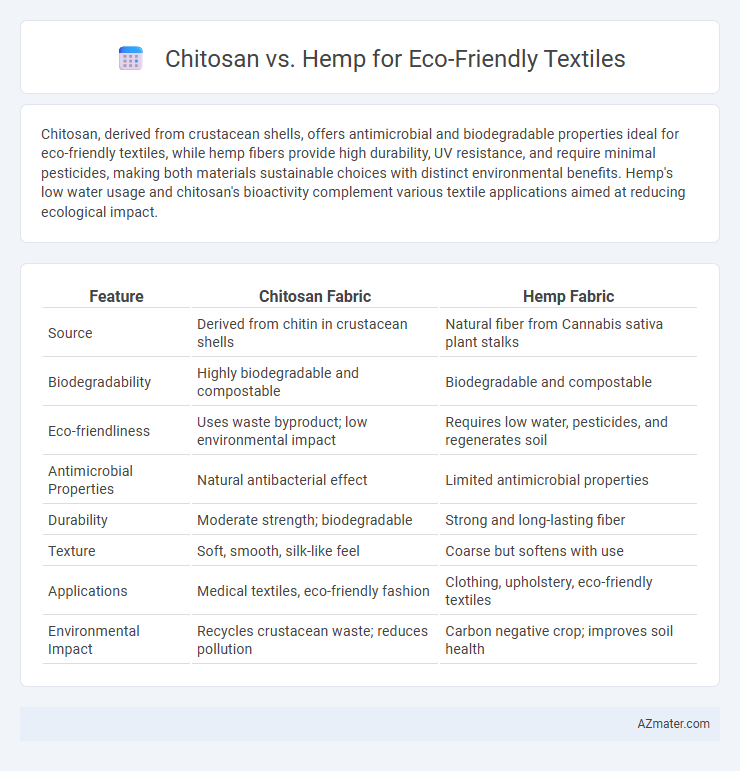Chitosan, derived from crustacean shells, offers antimicrobial and biodegradable properties ideal for eco-friendly textiles, while hemp fibers provide high durability, UV resistance, and require minimal pesticides, making both materials sustainable choices with distinct environmental benefits. Hemp's low water usage and chitosan's bioactivity complement various textile applications aimed at reducing ecological impact.
Table of Comparison
| Feature | Chitosan Fabric | Hemp Fabric |
|---|---|---|
| Source | Derived from chitin in crustacean shells | Natural fiber from Cannabis sativa plant stalks |
| Biodegradability | Highly biodegradable and compostable | Biodegradable and compostable |
| Eco-friendliness | Uses waste byproduct; low environmental impact | Requires low water, pesticides, and regenerates soil |
| Antimicrobial Properties | Natural antibacterial effect | Limited antimicrobial properties |
| Durability | Moderate strength; biodegradable | Strong and long-lasting fiber |
| Texture | Soft, smooth, silk-like feel | Coarse but softens with use |
| Applications | Medical textiles, eco-friendly fashion | Clothing, upholstery, eco-friendly textiles |
| Environmental Impact | Recycles crustacean waste; reduces pollution | Carbon negative crop; improves soil health |
Introduction to Eco-Friendly Textile Innovations
Chitosan, derived from crustacean shells, offers antimicrobial properties and biodegradability, making it a sustainable choice for eco-friendly textiles. Hemp fibers provide exceptional durability, minimal water usage, and carbon sequestration benefits, positioning hemp as a leading renewable resource in textile production. Both materials contribute significantly to reducing environmental impact and advancing innovations in sustainable fabric development.
Understanding Chitosan: Source and Properties
Chitosan, derived from the shells of crustaceans such as shrimp and crabs, is a biodegradable and non-toxic biopolymer widely used in eco-friendly textiles due to its antimicrobial and moisture-wicking properties. Its molecular structure enables strong film formation, enhancing fabric durability and breathability while reducing harmful chemical use in textile processing. Compared to hemp, a natural fiber known for strength and sustainability, chitosan offers unique functional benefits that improve textile performance and environmental impact.
The Rise of Hemp in Sustainable Textiles
Hemp has become a leading material in sustainable textiles due to its rapid growth, low water requirements, and natural resistance to pests, making it a highly eco-friendly crop. Unlike chitosan, which is derived from shellfish waste and offers antimicrobial properties, hemp fibers provide superior durability and breathability for fabric production. The rise of hemp in the textile industry reflects a shift toward renewable resources that minimize environmental impact while promoting biodegradable and recyclable clothing options.
Chitosan Textile Processing Techniques
Chitosan textile processing techniques involve applying chitosan-based coatings or finishing agents that enhance fabric properties such as antibacterial activity, moisture retention, and biodegradability. Processes like padding, spraying, or immersion allow effective absorption of chitosan on natural fibers, improving dye affinity and durability without toxic chemicals. Compared to hemp, chitosan-treated textiles offer advanced functional benefits while maintaining eco-friendly and renewable resource usage in sustainable textile manufacturing.
Hemp Fabric Production and Environmental Impact
Hemp fabric production involves minimal water usage and requires no synthetic pesticides or herbicides, significantly reducing its environmental footprint compared to conventional textiles. The natural fibers of hemp are biodegradable and promote soil health by replenishing nutrients during crop rotation. Chitosan, while biodegradable and antimicrobial, depends on crustacean shells often sourced from industrial waste, making hemp a more sustainable choice for eco-friendly textile production.
Comparing Biodegradability: Chitosan vs Hemp
Chitosan, derived from crustacean shells, exhibits excellent biodegradability due to its natural polysaccharide structure, breaking down rapidly in soil and aquatic environments within weeks. Hemp fibers, composed of cellulose, offer high biodegradability but decompose more slowly, typically over several months, contributing to soil health by releasing nutrients during breakdown. Both materials are sustainable choices for eco-friendly textiles, but chitosan's faster biodegradation rate makes it especially suitable for applications requiring quick environmental assimilation.
Functional Benefits: Antimicrobial and Hypoallergenic Qualities
Chitosan fibers exhibit strong antimicrobial properties by inhibiting bacterial growth, making them ideal for medical textiles and activewear, while being naturally hypoallergenic to reduce skin irritation. Hemp fibers also offer antimicrobial benefits due to their natural lignin content and provide excellent breathability and hypoallergenic qualities, suitable for sensitive skin and sustainable fashion. Both materials enhance textile functionality by combining eco-friendliness with health-conscious performance features.
Performance and Durability in Textile Applications
Chitosan fibers exhibit superior antimicrobial properties and enhanced moisture management, making them highly effective for eco-friendly textile applications requiring hygiene and comfort. Hemp fibers are renowned for their exceptional tensile strength and durability, contributing to long-lasting and abrasion-resistant fabrics ideal for sustainable fashion and industrial use. Combining chitosan's bioactive features with hemp's mechanical robustness offers a promising approach to optimizing both performance and durability in green textiles.
Market Trends and Consumer Preferences
Chitosan and hemp are gaining traction in the eco-friendly textile market due to their sustainable properties and biodegradability. Market trends reveal a growing preference for hemp textiles driven by consumer demand for natural fibers with high durability and minimal environmental impact. Chitosan, valued for its antimicrobial properties and biodegradability, appeals to niche sectors focusing on functional textiles, but hemp currently dominates mainstream eco-conscious consumer preferences.
Future Prospects: Chitosan and Hemp in Green Fashion
Chitosan and hemp represent promising materials in the future of green fashion due to their biodegradability and renewable nature. Chitosan, derived from chitin in crustacean shells, offers antimicrobial properties and enhances fabric durability, making it ideal for sustainable textiles. Hemp's rapid growth, low water usage, and ability to improve soil health position it as a leading fiber in eco-friendly clothing production.

Infographic: Chitosan vs Hemp for Eco-friendly Textile
 azmater.com
azmater.com